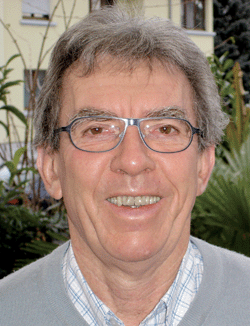Introduction to the themed issue in honour of Jean-Pierre Sauvage
Jean-Pierre Sauvage was born in Paris, France in 1944. He studied chemistry at the Ecole Nationale Supérieure de Chimie de Strasbourg and obtained his PhD from the Université Louis Pasteur de Strasbourg under the supervision of Jean-Marie Lehn (1971). After postdoctoral research in Oxford, UK with Malcolm L. H. Green (1973–1974), he went back to Strasbourg, where he is now a CNRS Director of Research. His scientific interests range from models of photosynthetic reaction centers using transition metal complexes and porphyrins to topology, molecular machines and nanomotors.
Jean-Pierre is a pioneer in the field of mechanically-interlocked molecular architectures. In 1983, he published, with Christiane Dietrich-Buchecker, the first templated and high-yielding synthesis of a catenane.1 This molecule, featuring two interlocked rings, opened up a new field of chemistry—that of interlocking molecules—now the subject of thousands of publications. They used a similar strategy to prepare the first molecular knot in 1989, an outstanding achievement in the field of molecular topology.2 Jean-Pierre has also shown that threaded or interlocking rings are ideally suited to the construction of molecular machines or motors, since large amplitude motions can be envisaged with such architectures. In this field, his paper on the electrochemically-triggered swinging of a [2]-catenane is considered by the community to be one of the very first examples of a molecular machine.3
Jean-Pierre has received several awards in recognition of his outstanding scientific achievements, among them the CNRS Silver Medal (1988), the Prelog Medal (1994) and the Pierre Süe Prize (2005). He was elected a correspondent member of the French Academy of Sciences on March 26, 1990 and a member on November 24, 1997.
In 2009, Jean-Pierre will turn 65, and this is the perfect opportunity to celebrate the outstanding significance of his ongoing contribution to chemistry by publishing a themed issue in his honour in NJC. Jean-Pierre has been closely connected to the journal, serving on the editorial board from 1998 to 2002 and then on the International Advisory Board for another four years. He has been a longtime supporter of NJC (since the days when it was called Nouveau Journal de Chimie), having published nearly 50 papers in the journal since 1977.
All the articles collected in this issue have been prepared by former co-workers, collaborators and friends from across the world. I would like to thank all of them for their collaboration and efforts to achieve this outstanding collection of manuscripts. Finally, my gratitude is extended to Denise Parent and Sarah Ruthven, NJC Editors, as well as to Jean-Pierre Majoral and Jerry Atwood for their support of this enterprise. The NJC editorial office is also gratefully acknowledged for their efficient handling of the manuscripts.
Together with the chemists contributing to this NJC themed issue and all of the NJC editors, I wish a happy birthday to Jean-Pierre; your contribution to science has been a tremendous source of inspiration to many chemists, and we all look forward to many more years of successful science.
Jean-François Nierengarten
(Université Louis Pasteur de Strasbourg, France)
References
- C. O. Dietrich-Buchecker, J.-P. Sauvage and J.-P. Kintzinger, Tetrahedron Lett., 1983, 24, 5095 CrossRef CAS.
- C. O. Dietrich-Buchecker and J.-P. Sauvage, Angew. Chem., Int. Ed. Engl., 1989, 28, 189 CrossRef.
- A. Livoreil, C. O. Dietrich-Buchecker and J.-P. Sauvage, J. Am. Chem. Soc., 1994, 116, 9399 CrossRef CAS.
| This journal is © The Royal Society of Chemistry and the Centre National de la Recherche Scientifique 2009 |

